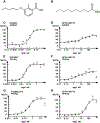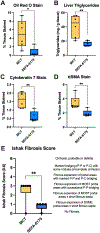A Medium-Chain Fatty Acid Analogue Prevents Intestinal Failure-Associated Liver Disease in Preterm Yorkshire Piglets
- PMID: 37263310
- PMCID: PMC10527514
- DOI: 10.1053/j.gastro.2023.05.035
A Medium-Chain Fatty Acid Analogue Prevents Intestinal Failure-Associated Liver Disease in Preterm Yorkshire Piglets
Abstract
Background & aims: At least 20%-30% of patients with intestinal failure receiving long-term parenteral nutrition will develop intestinal failure-associated liver disease (IFALD), for which there are few therapeutic options. SEFA-6179 is a first-in-class structurally engineered medium-chain fatty acid analogue that acts through GPR84, PPARα, and PPARγ agonism. We hypothesized that SEFA-6179 would prevent biochemical and histologic liver injury in a preterm piglet model of IFALD.
Methods: Preterm Yorkshire piglets were delivered by cesarean section, and parenteral nutrition was provided for 14 days via implanted central venous catheters. Animals were treated with either medium-chain triglyceride vehicle control or SEFA-6179.
Results: Compared to medium-chain triglyceride vehicle at day of life 15, SEFA-6179 prevented biochemical cholestasis (direct bilirubin: 1.9 vs <0.2 mg/dL, P = .01; total bilirubin: 2.7 vs 0.4 mg/dL, P = .02; gamma glutamyl transferase: 172 vs 30 U/L, P = .01). SEFA-6179 also prevented steatosis (45.6 vs 13.9 mg triglycerides/g liver tissue, P = .009), reduced bile duct proliferation (1.6% vs 0.5% area cytokeratin 7 positive, P = .009), and reduced fibrosis assessed by a masked pathologist (median Ishak score: 3 vs 1, P = 0.007). RNA sequencing of liver tissue demonstrated that SEFA-6179 broadly impacted inflammatory, metabolic, and fibrotic pathways, consistent with its in vitro receptor activity (GPR84/PPARα/PPARγ agonist).
Conclusions: In a preterm piglet model of IFALD, SEFA-6179 treatment prevented biochemical cholestasis and steatosis and reduced bile duct proliferation and fibrosis. SEFA-6179 is a promising first-in-class therapy for the prevention and treatment of IFALD that will be investigated in an upcoming phase II clinical trial.
Keywords: Animal; Cholestasis; Intestinal Failure; Liver Diseases/Drug Therapy; Models; Parenteral Nutrition.
Copyright © 2023 The Authors. Published by Elsevier Inc. All rights reserved.
Conflict of interest statement
This study was primarily funded via a sponsored research agreement with NorthSea Therapeutics. Dr. Fraser is the Chief Scientific Officer of NorthSea Therapeutics and was responsible for the
Figures







Similar articles
-
A medium-chain fatty acid analogue prevents hepatosteatosis and decreases inflammatory lipid metabolites in a murine model of parenteral nutrition-induced hepatosteatosis.PLoS One. 2023 Dec 1;18(12):e0295244. doi: 10.1371/journal.pone.0295244. eCollection 2023. PLoS One. 2023. PMID: 38039287 Free PMC article.
-
Inflammation drives pathogenesis of early intestinal failure-associated liver disease.Sci Rep. 2024 Feb 20;14(1):4240. doi: 10.1038/s41598-024-54675-9. Sci Rep. 2024. PMID: 38378873 Free PMC article.
-
Prediction, identification and progression of histopathological liver disease activity in children with intestinal failure.J Hepatol. 2021 Mar;74(3):593-602. doi: 10.1016/j.jhep.2020.09.023. Epub 2020 Sep 28. J Hepatol. 2021. PMID: 33002568
-
The gut microbiome and intestinal failure-associated liver disease.Hepatobiliary Pancreat Dis Int. 2023 Oct;22(5):452-457. doi: 10.1016/j.hbpd.2023.07.002. Epub 2023 Jul 9. Hepatobiliary Pancreat Dis Int. 2023. PMID: 37453856 Review.
-
Current Insights Regarding Intestinal Failure-Associated Liver Disease (IFALD): A Narrative Review.Nutrients. 2023 Jul 17;15(14):3169. doi: 10.3390/nu15143169. Nutrients. 2023. PMID: 37513587 Free PMC article. Review.
Cited by
-
Medium-chain fatty acid receptor GPR84 deficiency leads to metabolic homeostasis dysfunction in mice fed high-fat diet.FASEB Bioadv. 2024 Oct 17;6(11):526-538. doi: 10.1096/fba.2024-00075. eCollection 2024 Nov. FASEB Bioadv. 2024. PMID: 39512839 Free PMC article.
-
Gut microbiota-derived tryptophan metabolites improve total parenteral nutrition-associated infections by regulating Group 3 innate lymphoid cells.Imeta. 2025 Feb 26;4(2):e70007. doi: 10.1002/imt2.70007. eCollection 2025 Apr. Imeta. 2025. PMID: 40236767 Free PMC article.
-
Fat malabsorption in short bowel syndrome: A review of pathophysiology and management.Nutr Clin Pract. 2024 Apr;39 Suppl 1(Suppl 1):S17-S28. doi: 10.1002/ncp.11119. Nutr Clin Pract. 2024. PMID: 38429962 Free PMC article. Review.
-
A medium-chain fatty acid analogue prevents endotoxin liver injury in a murine model.Sci Rep. 2025 Apr 20;15(1):13645. doi: 10.1038/s41598-025-98200-y. Sci Rep. 2025. PMID: 40254678 Free PMC article.
-
Curcumin: A Natural Warrior Against Inflammatory Liver Diseases.Nutrients. 2025 Apr 18;17(8):1373. doi: 10.3390/nu17081373. Nutrients. 2025. PMID: 40284236 Free PMC article. Review.
References
-
- Lauriti G, Zani A, Aufieri R, et al. Incidence, prevention, and treatment of parenteral nutrition-associated cholestasis and intestinal failure-associated liver disease in infants and children: a systematic review. JPEN J Parenter Enteral Nutr 2014;38:70–85. - PubMed
-
- Christensen RD, Henry E, Wiedmeier SE, et al. Identifying patients, on the first day of life, at high-risk of developing parenteral nutrition-associated liver disease. J Perinatol 2007;27:284–290. - PubMed
-
- Lee WS, Chew KS, Ng RT, et al. Intestinal failure-associated liver disease (IFALD): insights into pathogenesis and advances in management. Hepatol Int 2020;14:305–316. - PubMed
Publication types
MeSH terms
Substances
Grants and funding
LinkOut - more resources
Full Text Sources
Other Literature Sources
Medical
Molecular Biology Databases
Research Materials

